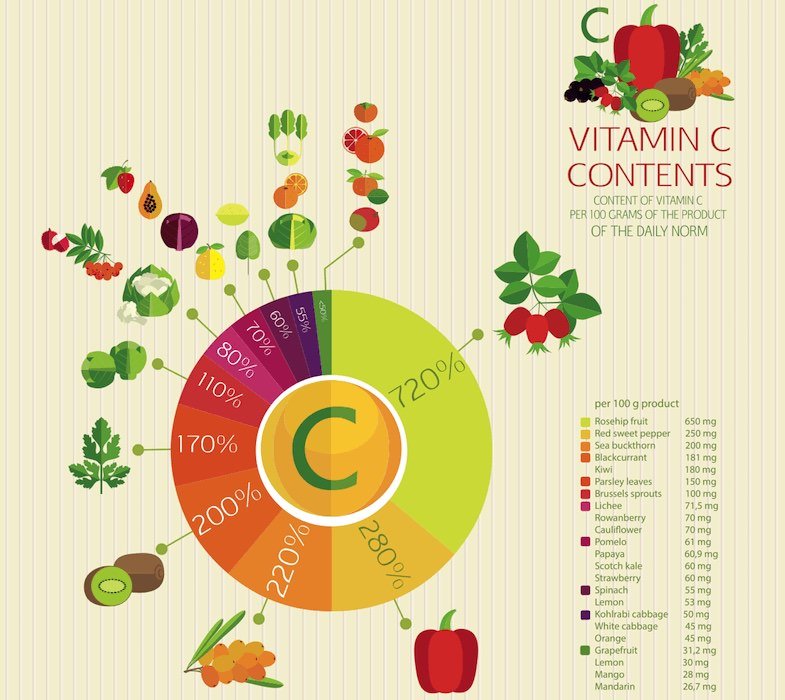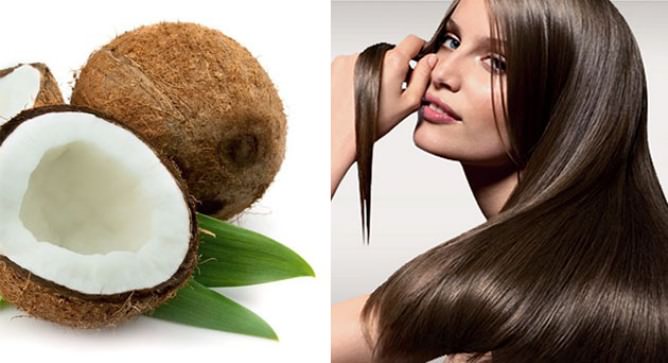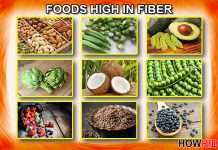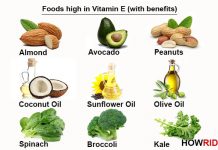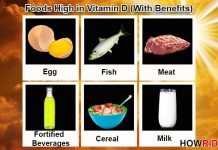After writing, foods high in vitamin d, foods high in vitamin k, and foods high in vitamin b12, we are now writing the top foods high in vitamin C. This article will tell you about the best vitamin C rich foods. Vitamin C is a form of the vitamin, which is also known as ascorbic acid. The human body cannot produce vitamin C on its own therefore, we have to consume a diet, which consists of food rich in Vitamin C. Our body needs ascorbic acid to make collagen. It is a very important substance for health as it repairs the tissues of the skin, cartilage, bone, teeth and blood vessels.
Deficiency of vitamin C leads to a disease known as scurvy. In this condition, the person tends to develop swelling in the body, especially in a foot. Anemia and exhaustion are common symptoms of vitamin C deficiency. Moreover, vitamin C makes the immune system strong thus, it helps to prevent cold, fever and a similar problem. Vitamin C is one of the effective and safest nutrients. This nutrient also helps to treat cardiovascular disease, eye diseases, wrinkles, hypertension, cancer and prenatal health problems as well. It is believed that lemon and orange are the main vitamin C rich foods. However, it is not true because there are many other foods high in vitamin C. Continue reading further to know the foods high in vitamin C or best vitamin C rich foods.
Various Foods High in Vitamin C (Vitamin C Rich Foods):
Contents
1.) Rose Hips (426mg per 100g, 710% DV)
This is one of the best fruits to increase vitamin C content in body. It is a fruit of rose plant that is useful in preparing herbal teas, jellies, syrup, jams and rose hip soup. It contains 426mg of vitamin C in 100g and this value make it one of the top most food high in vitamin C. Apart from vitamin C, this fruit is rich in dietary fiber and vitamin A. Here are some ways to use this fruit in your daily diet. You can add rose hips to your cake or ice-cream. Have a cup of rose hip soup. Spread rose hip jam on a slice of toast.
2.) Chili Pepper
Red Chili Pepper (143mg per 100g & 239% DV), Green Chili Pepper (242mg per 100g, 404% DV).
Yes, chili pepper! Often people believe that chili pepper is added to dishes just to spice up the food and add good taste. However, the benefits of chili pepper are not restricted to the good taste only. It contains an alkaloid compound, known as capsaicin. The compound gives it a strong pungent character. It has anti-carcinogenic, anti-bacterial, anti-diabetic and analgesic properties that keep you healthy. It also reduces LDL cholesterol among obese. Chilly contains minerals such as manganese, magnesium, potassium and iron in abundance. Potassium helps to control the heart rate and blood pressure. Whereas, manganese enhances the activity of enzymes in the body.
3.) Guava (228.3mg per 100g, 380% DV)
Guava is counted among the exotic fruits and also food high in vitamin C. Consuming guava has a lot of benefits for your health. If you are a lover of fruits then you will love to add guava in your daily diet. You can even add it while you prepare your fruit salads. Guava is also known to be rich in folic acid, manganese, dietary fibers and potassium. Ripe guavas are loaded with lots of vitamin C. One guava contains about 126mg of vitamin C. This means that if you are eating a guava one day then you need not worry about the vitamin C content in your body for the next few days.
Here are some ways to include guava into your daily diet. You can consume guava in raw form. Add guava slices to your salad plate that include carrot, apples, cucumber and beetroot. You can have guava juice with a pinch of himalayan salt. Consume guava jelly on a toast and enjoy the taste. Guava prevents from diabetics, improves the eye sight, prevent constipation and reduces the risk of cancer. It works as medicine as you consume it when you suffer from dysentery and diarrhea.
4.) Bell Peppers
Green Bell Pepper (80mg per 100g & 134% DV), Red Bell Pepper (127mg per 100g & 212% DV), Yellow Bell Pepper (183mg per 100g & 305% DV).
Bell peppers are known to be food high in vitamin C along with beta carotene. It is counted among vitamin C rich vegetables. Try to include the bell peppers in your diet to maintain a healthy balance of vitamin C in your body. Yellow bell peppers are highly recommended followed by red peppers and green bell peppers. Bell pepper also known as sweet peppers and capsicum in some parts of the country also contains capsaicin. It is a good source of carotenoids (a pigment that gives the color to the vegetables and fruits).
Ripe bell peppers contain more vitamin C and carotenoids. It has a tangy and crunchy taste which refreshes the flavor of the dish. Red bell pepper is considered more nutritious than green and yellow bell pepper since it contains the double percentage of nutrients and antioxidants. It is a good source of vitamin C and helps in the absorption of iron. All this advantage, the veggie is a boon for anemics. Also, it increases the metabolism rate, prevents cataract problem, prevents from formation of blood clots and reduces the risk of heart attacks and strokes.
5.) Kale (120mg per 100g , 200% DV)
Kale is a form of green leafy vegetable that is packed with various nutrients. It contains a low amount of fat, and the fat, which it contains is omega-3 fatty acid also called alpha-linolenic acid. It is a good fat. Kale is loaded with the antioxidants such as beta carotene, flavonoids, polyphenols and Vitamin C. The antioxidants slower’s the aging process. It helps in reduces the cholesterol level. Low cholesterol means less risk of heart disease. It also reduces the risk of disease such as cancer. It is also a good source of calcium, a nutrient important for bone health. Moreover, it has low in oxalate, a substance in green leafy vegetables, which does not let the minerals to absorbed in the body. Because of all these advantages, it is considered as the best food high in vitamin C.
6.) Papaya (60mg per 100g, 101% DV)
Papaya is an excellent source of vitamin C, fiber, and antioxidants that stop the accumulation of cholesterol in the arteries, which could block the arteries and cause a heart attack. It contains papain, which helps in the formation of the collagen. Papayas intake also reduces the risk of diabetes. Moreover, it help in weight loss, boost immunity, good for eyes, protect against arthritis pain. It can also reduce the menstrual cramp and helps to prevent the signs of aging. It reduces stress, promotes hair growth and reduces the risk of cancer. Apart from these advantages, the fruit is good for the skin as well. It removes the tanning and gives you clear and glowing skin. However, pregnant women should avoid intake of papaya.
7.) Cauliflower (48.2 mg per 100g , 80% DV)
Another green leafy vegetable, which has a good amount of vitamin C is cauliflower. It is anti-inflammatory in nature and contains antioxidants. It reduces the stress. A compound known as sulforaphane is present in this vegetable which helps to control cancer. It boosts heart health and memory power. Moreover, it is a good source of other nutrients such as protein, Vitamin K, thiamin, magnesium, niacin, riboflavin, folate, fiber, manganese, potassium and many more nutrients.
8.) Broccoli (89.2mg per 100g, 148% DV)
Green vegetable like broccoli is not only for health but also in taste. Many of you love to add broccoli in your daily intake of foods. But the ones who consume less try to add more of in your diet. Broccoli belongs to a cruciferous family. According to recent findings, cruciferous reduces the risk of cancer, especially colon, and lung cancer. It also contains folate, which helps to reduce the risk of breast cancer. So all the ladies reading this article, do introduce this healthy vegetable into your diet. The other benefits of broccoli are: it improve bone health, digestion, protects from chronic disease such as hypertension, obesity, diabetes, gastroenteritis disease, controls blood pressure.
9.) Strawberries (58.8mg per 100g, 97% DV)
The juicy fruit is packed with the goodness of antioxidants. It boosts the immunity, promote healthy eyes and helps to prevent cancer. And most importantly, regular eating strawberries will give you flawless skin and keep the wrinkles at the bay. So girls, what are waiting for? Start eating strawberries from today. It also combats with bad cholesterol, regulate blood pressure, helps in digestion. And yes, it can help you to lose weight as well.
10.) Brussels Sprouts (85mg per 100g, 141% DV)
Brussels sprouts are small cabbages and food high in vitamin C. The biggest advantage of this vegetable is that it helps to reduce body weight because they are one of the low-glycemic nutritious vegetables. It provides high fat, protein, and 0 cholesterol. It is also a good source of other antioxidants, such as Vitamin A and K. Brussel sprouts also supply minerals such as calcium, iron, potassium, copper and etc. Among which potassium controls the heart rate and blood pressure. Manganese enhances the formation of enzymes and iron promotes red blood cells formation.
11.) Kiwi Fruit (92.7mg per 100g, 154% DV)
The kiwi fruit has more of vitamin C content in comparison to orange. Kiwi is also rich in potassium. The intake of kiwi in your daily diet will be beneficial for you. This citrus fruit is enriched with amazing nutrients. It helps in digestion, controls blood pressure, strengthens the immune system, flush out the toxins and promotes weight loss. It also fights back with heart disease. Moreover, it is good for skin. People suffering from diabetes should include this fruit in their diet. It also helps to maintain a beautiful healthy skin and its texture.
12.) Pineapple (47.8mg per 100g, 79% DV)
Drink a glass of pineapple juice to keep the health disease at the bay. Apart from healthy benefits, the fruit is packed with all the important nutrients. It has beauty benefits such as, it makes your hair thick, gives you glowing skin and soft nails. If you experience gum problem then pineapple can surely aid you. Also, it is good for eyes.
13.) Clementine (48.8mg per 100g, 81% DV)
This is one of the richest sources of vitamin C. Clementine is actually a hybrid between a mandarin orange and a sweet orange. 100gm of this pulpy and juicy fruit contains 48.8mg of vitamin C. In other words, one clementine is loaded with 19.5mg of vitamin C. Clementine is also high in potassium, vitamin A, phosphorous, calcium and dietary fiber. Here are some ways to include clementine in your daily diet. You can consume this whole fruit or drink its juice. Mix Clementine juice to cup cakes, tarts and chocolate fondue. Add Clementine juice to your vegetable smoothie. Consume clementine salad daily.
14.) Collard Greens (35.3mg per 100g, 58% DV)
This highly nutritious leafy green vegetable is similar to spinach. 9.9mg of vitamin C is present in one ounce of collard greens. 100gm of collard greens contains 35.3mg of vitamin C. Collard greens are also loaded with vitamin A, potassium, calcium and dietary fiber. Here are some ways to include this green vegetable in your daily diet. You can add this leafy green vegetable to your salad plate. Cook collard greens with tofu, pasta, white beans and shrimp. You can add collard greens to your chicken soup or mushroom.
15.) Swiss Chard (30mg per 100g, 50% DV)
This is one of the richest sources of vitamin C. The red stems and dark green leaves of swiss chard is very nutritious and high in vitamin C. 100gm of swiss chard contains 30mg of vitamin C. One leaf of Swiss chard is loaded with 14.4mg of vitamin C. Swiss chard is also rich in calcium, potassium, vitamin A, magnesium and dietary fiber. Here are some ways to use Swiss chard in your daily diet. You can add Swiss chard leaves into a bowl of soup or stew. Swiss chard sandwiches or shrimp wraps are a great option. You can add Swiss chard to your daily diet. Add Swiss chard to your quiche to make it healthy.
16.) Gooseberry (27mg per 100g, 47%)
This is one of the richest sources of vitamin C. It is easily found in India, Bangladesh, Sri Lanka and other European countries. Gooseberries are famous for their health benefits. 27.7gm of vitamin C is present in 100gm of gooseberry. Gooseberry is also high in potassium, vitamin A, dietary fiber and omega-3-fatty acids. Here are some ways to include gooseberry in your daily diet. Consume it as a whole fruit. Dry some gooseberries in the sun and consume 2 to 3 pieces daily. Drink gooseberry juice on a regular basis. Add gooseberry to your smoothie. Prepare gooseberry pickle and eat it with lunch or dinner.
17.) Cantaloupe Melon (36.7mg per 100g, 61% DV)
It is a watery fruit that is good for your health. The consumption of cantaloupe fruit will keep your body hydrated. It contains beta carotene and potassium. Reduces the risk of asthma and helps to reduce obesity. Lowers your blood pressure level, prevents from cancer, improves your digestion, reduces inflammation and promotes healthy skin and hair.
18.) Tomatoes (13.7mg per 100g, 22% DV)
This bright red vegetable is a rich source of vitamin C. The intake of tomatoes in your daily diet will help you overcome your deficiencies. Tomatoes are the rich source of vitamin C with potassium, vitamin A, manganese, phosphorus, fiber and protein. The sun-dried tomatoes are very high in nutrition. 39.2mg of vitamin C is present in 100g of sun-dried tomatoes. Fresh tomatoes contain 13.7mg of vitamin C. Here are some ways to include tomatoes in your daily diet. Have one glass of tomato juice in the morning. Use tomatoes while cooking food and curries. You can add tomatoes to your sandwich and salad plate. It reduces your cholesterol level, improves your digestive system, lowers the hypertension, improves eye sight and prevents from urinary tract infections.
19.) Green Peas (40mg per 100g, 66% DV)
Fresh green peas are high in vitamin C and are also a good source of proteins. It is a rich source of vitamin C, iron and other nutrients. It minimizes the risk of cancer, depression, macular degeneration and high cholesterol. Here are some ways to include green peas in your diet. You can cook green peas with mashed potatoes. Add green peas to your bowl of soup or salad. Add green peas to stews and curries.
20.) Kohlrabi (62mg per 100g, 103%)
This German turnip is loaded with lots of vitamin C. The taste of kohlrabi is similar to Brussels, broccoli and cabbage. It is also high in dietary fiber. German Turnip is also rich in calcium, vitamin A and phosphorous. 62mg of vitamin C is present in 100g of kohlrabi. In other words, 83.7mg of vitamin C is present in one cup of kohlrabi. Here are some ways to include kohlrabi in your daily diet. You can make chips with this German Turnip. Add it to soup and stews. Consume roasted German Turnips. Add it to slaws and salads.
21.) Watercress (43mg per 100g, 71% DV)
This is one of the richest sources of vitamin C. This nutritious aquatic plant is a very healthy leafy vegetable. Watercress is loaded with vitamin K, potassium, calcium and vitamin A. Another benefit of watercress is that it has zero cholesterol so you don’t have to worry about your weight. 14.6mg of vitamin C is present in one cup of chopped watercress. Here are some ways to include it in your diet. Prepare a smoothie with this watercress. Add watercress to your salad plate. Make a soup with watercress.
22.) Lambsquarter (80mg per 100g, 133% DV)
Lambsquarters is also known as bacon weed, which is easy to grow in your kitchen garden. If you can’t grow it, just buy it from a nearby grocery store or from a farmers market. 80mg of vitamin C is present in 100g of lambsquarter. Here are some ways to include lambsquarter in your daily diet. You can have a omelete with lambsquarters. Prepare a delicious plate of salad with apples, apricots, beetroot, tomato and lambsquarter. You can eat it with other veggies or chicken breast.
23.) Oranges (53.4mg per 100g, 88% DV)
Oranges are known to be one of the best citrus fruit. It’s healthy for you. Try to include orange in your daily diet. If you do not like to consume it raw directly, try to have the fresh orange juice. And avoid the contaminated juice. It helps to balance your blood pressure. Reduces the risk of cancer and improves your heart health. Reduces the risk of diabetics and promotes beautiful and healthy skin.
24.) Clove (80.8mg per 100g, 101% DV)
This Indian spice is famous for adding taste to a variety of dishes. It is a common ingredient that is found in almost every kitchen. Clove is one of the highest sources of vitamin C. 100gm of clove is loaded with 80.8mg of vitamin C. In other words, one teaspoon of clove powder is filled with 1.6mg of vitamin C. The antiseptic and anti-inflammatory properties of clove are very good to treat wisdom toothache. Here are some ways to include clove in your daily diet. You can add clove while making curries. Add cloves to a plain bowl of rice. Mix half teaspoon of clove powder in a glass of juice or smoothie. Chew buds of clove just like a mouth freshener.
Benefits of Vitamin C:
- It reduces hypertension and minimizes the risk of developing cataracts.
- Vitamin C helps to prevent cancer.
- It helps to keep the gums healthy.
- It helps to regulate the blood sugar levels.
- Vitamin C combats strokes and helps to maintain the mood.
- It helps to treat eczema and minimizes wrinkles and treats sun damage.
- It promotes hair growth and fights dandruff.
- Vitamin C improves the texture of the skin and helps in healing wounds and burns.
- It encourages weight loss and improves heart health.
- Vitamin C prevents scurvy and helps in treating viral infections.
- It minimizes the risk of developing urinary tract infection.
- It controls asthma and cure diabetes. You can read article benefits of vitamin C to know in detail.


